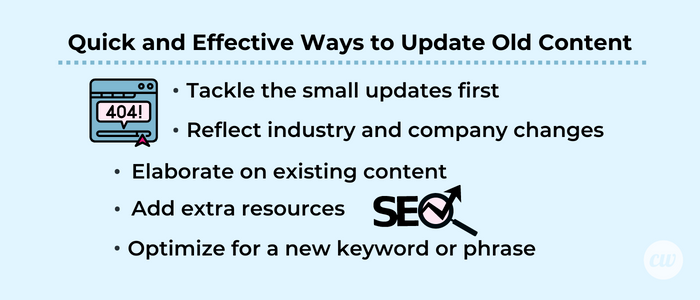
4 Reasons Why You Should Refresh Your Content and Effective Ways to Do It
There are several ways to approach a content marketing strategy. Some approaches will generate qualified leads for your business. Others will increase audience engagement. And some will fail to produce any results, no matter how hard you try.
No matter which strategy route your team chooses, it’s important to work smarter — not harder.
That’s why refreshing old content has become a common and effective tactic for content marketing teams. Content refreshing refers to the practice of updating old content with new information, formatting, and other improvements to better serve readers today.
But why do marketers take this approach? What benefit does it provide?
As the content marketing landscape becomes increasingly more competitive with each day, content refreshing provides advantages such as improved SEO results, increased traffic, brand relevance, and more efficient content processes.
1. Search Ranking Improvements
One of the most convincing arguments for refreshing old content comes from Hubspot. A thorough analysis of its blog performance showed that 72% of monthly blog views and 92% of blog leads came from older posts.
What’s even more impressive is that 46% of those leads came from just 30 posts.
This mind-blowing data means that less than 1% of Hubspot’s blog content was responsible for almost half of the company’s blog-driven leads.
These findings led Hubspot’s team to dive deep into rephrasing and reoptimizing old content to perform better in the long run. After transforming their content strategy to simultaneously generate new content and update old content, the increases in the team’s search ranking answered the results of the data’s findings.
Remember, Google considers content “freshness” as a ranking factor. To test this, Search Engine Journal’s team embarked on a content updating project and saw pageviews double as a result.
2. New Website Traffic
As a result of your improved search rankings, your old — but now newly refreshed — content should experience an uptick in qualified website traffic.
One study found that refreshing old content increased a website’s traffic by 96%.
The reasoning behind this significant jump in traffic is simple: the updates made to the content in this case study led to higher search rankings. The improved visibility on search engines for evergreen or relevant topics leads to more opportunities for readers to click through to your website, effectively generating new traffic to your website.
Additionally, we know inbound links are also a ranking factor. But websites don’t want to waste a precious external link on content that’s old, stale, or no longer accurate. By regularly updating content, you increase the likelihood of earning well-deserved backlinks from other authoritative websites and improving referral traffic to your site as a result.
3. Brand Relevance
No matter what industry or niche you write for, there will always be trending topics to take advantage of. Just as there will always be evergreen topics to create foundational content pillars.
By updating old evergreen topics, your brand can climb to page one of Google and position the company as a relevant authority on the topic.
Think about your search habits. Would you click through to and trust an outdated article, or one regularly updated with new and useful information?
As you work to establish your branded content as fresh, relevant, and trustworthy, you’ll notice more engaged and qualified traffic coming to your site from numerous sources including search engines, referral websites, and more.
4. Content Strategy Efficiencies
Remember, to work smarter, not harder!
Content marketing teams are often so quick to believe that more content equals better results. And while that may be true in some contexts, it leads to burnout in team members, exhausted resources, and less time to focus on grander initiatives.
Instead of putting all your effort into new content that slightly moves the needle, focus on updating old content for better use of time and results.
Doing so will fill in the gaps on your content calendar, creating a full schedule of relevant, timely, and engaging content for your audience. Your team won’t have to worry about coming up with new topics or rushing to meet a deadline.
How To Decide What Content to Refresh
Of course, not all content is worth updating. An article about a past event, for example, won’t benefit from being updated unless there are new developments to the event or it’s an annual occasion.
And some content should have priority over others. But how do you decide which content to update first?
Follow these quick steps to determine which updated content should take priority in your content calendar:
- Review website traffic — Take a look at your website’s top content (sorted by website traffic) for the last year. Which content pieces generated the most traffic to your website? From here find a piece of content that generates significant traffic but has recently dropped.
- Look at the age — Review the top-performing content and jot down the date each piece was published and/or last updated. You should refresh content that is at least a year old.
- Analyze the topics — Prioritize evergreen, or industry-related topics you know will continue to generate traffic for months and years to come. Plus, you can always adjust an article’s topic to become more evergreen!
- Consider brand and team initiatives — Last, think about any upcoming brand and team initiatives. Would updating articles and receiving a boost of traffic over time benefit these projects?
After completing these steps, you should have a list of content that’s ready to be updated.
Quick and Effective Ways to Refresh Content
Each piece of content will require unique updates. Here are a few ways you can quickly and effectively update each article.

Tackle the Small Updates First
Old content will inevitably have several small things you can update right off the bat. These include:
- Broken or irrelevant links
- Past dates
- Outdated references
- Broken or outdated images
- Formatting changes for readability
- Spelling errors
Some articles — especially those with pillar content potential — may only need small updates like these. For others, they’re just the beginning.
Reflect Industry and Company Changes
If your industry or company has experienced significant changes, your content should be updated to reflect this.
For example, many SEO backlinking tactics are no longer relevant or practiced by marketing departments today. Instead of simply deleting the article because the practices are not the industry standard, update the article to reflect linking strategies or tactics that move the needle in today’s market.
Elaborate on Existing Content
In an effort to be brief or to the point, a lot of context or explanation gets left on the cutting room floor before content is published. Consider if aspects of old content can be further elaborated on.
Perhaps there are new studies that back up your point. Maybe new company products or services provide a further foundation for the context of an old article. Or maybe the content is too short to thoroughly educate readers about the topic at hand.
Ask yourself, “What information can I add to enhance the context of this article or provide additional value for readers?”
Add Extra Resources
One great way to update content is to upload new media and resources to enhance the experience. This can be accomplished by adding:
- Photos and videos to break up large groups of text
- Downloadable resources
- Callouts to relevant articles and resources
- Email newsletter signup forms
But before you fill your content with resource after resource, be sure to only add those that contribute value to the reading experience. Adding photos and videos for the sake of having new media on the page won’t necessarily lead to the results you want. It may even slow down the page speed or disrupt the reading experience entirely.
Have a strategy behind each of the extra resources or new media you add to an older piece of content. Always make sure it’s relevant, too. Callout boxes for random articles won’t lead to the click-through rate results you’re hoping to generate, for example.
Optimize for a New Keyword or Phrase
Depending on the content’s current search ranking and traffic, you may decide to optimize the piece for a different keyword or phrase, particularly one with better ranking opportunities.
Keep in mind that this approach will require a bit more research and rewriting than the other ways to update content. Be sure to block out enough time on your content calendar to effectively tackle reoptimizing content. You don’t want to rush it and lose all existing ranking power!
Pro Tip: Results Won’t Happen Overnight
Remember, it takes time for search engines to recognize the changes you’ve made to old content. Fixing a few links, adding more photos, and rephrasing a couple of paragraphs won’t lead to a Page One ranking overnight. Keep a steady balance between creating new content and refreshing old content and you’ll begin to see the results over time.
Anne is a copywriter and digital marketing specialist currently residing in the Greater Nashville area. Originally from New England, she leverages her three top talents (writing, marketing, and coffee consuming) for businesses and brands of all sizes across the globe.
Anne is a 2013 Marketing Communications/Advertising graduate from Western New England University in Springfield, MA. She credits her launch into writing to her legendary elementary school poem about pizza that wowed the judges and won the creative writing award in her school district.
When not writing or working on marketing campaigns, you can find Anne at a coffee shop, exploring somewhere new, or training in martial arts as a 3rd degree black belt.




